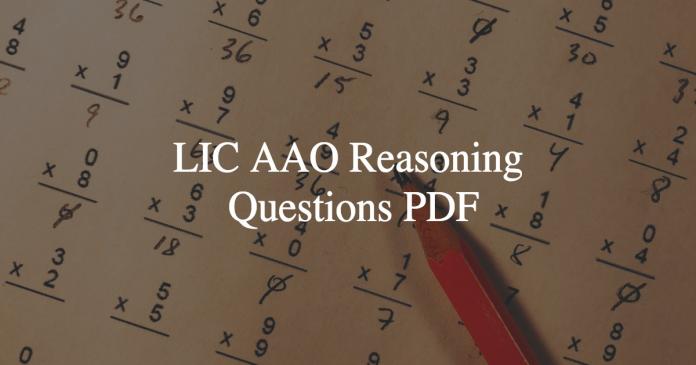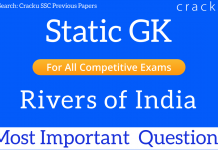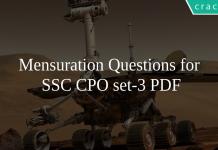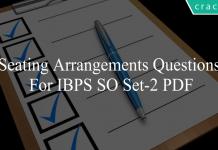LIC AAO Reasoning Questions PDF:
Download LIC AAO Reasoning questions with answers PDF based on previous papers very useful for Insurance exams. 30 Very important Reasoning objective questions for LIC AAO exams.
LIC AAO REASONING QUESTIONS PDF
Download LIC AAO Previous Papers PDF
Instructions
In each of the following questions, relationship between different
elements is shown in the statements. The statements are followed by two Conclusions
numbered I and II. Study the Conclusions based on the given statement and select the
appropriate answer.
Give answer a: if neither Conclusion I nor Conclusion II is true
Give answer b: if either Conclusion I or Conclusion II is true
Give answer c: if only Conclusion II is true
Give answer d: if both the Conclusion I and Conclusion II are true
Give answer e: if only Conclusion I is true
Question 1: Statements :
V < E > B = H ≥ N ; B ≤ T
Conclusions :
I. T > V
II. N ≤ T
a) if neither Conclusion I nor Conclusion II is true
b) if either Conclusion I or Conclusion II is true
c) if only Conclusion II is true
d) if both the Conclusion I and Conclusion II are true
e) if only Conclusion I is true
Question 2: Statements :
L = I ≥ N < E ; N ≥ S
Conclusions :
I. S = L
II. L > S
a) if neither Conclusion I nor Conclusion II is true
b) if either Conclusion I or Conclusion II is true
c) if only Conclusion II is true
d) if both the Conclusion I and Conclusion II are true
e) if only Conclusion I is true
Question 3: Statements :
L = I ≥ N < E ; N ≥ S
Conclusions :
I. S < E
II. E > L
a) if neither Conclusion I nor Conclusion II is true
b) if either Conclusion I or Conclusion II is true
c) if only Conclusion II is true
d) if both the Conclusion I and Conclusion II are true
e) if only Conclusion I is true
Download LIC AAO Previous Papers PDF
100 Free Computer Awareness Tests for LIC
Question 4: Statements :
B > E ≥ A < L; T ≥ A > S
Conclusions :
I. B > S
II. L > S
a) if neither Conclusion I nor Conclusion II is true
b) if either Conclusion I or Conclusion II is true
c) if only Conclusion II is true
d) if both the Conclusion I and Conclusion II are true
e) if only Conclusion I is true
Question 5: Statements :
B > E ≥ A < L; T ≥ A > S
Conclusions :
I. T ≥ B
II. L > T
a) if neither Conclusion I nor Conclusion II is true
b) if either Conclusion I or Conclusion II is true
c) if only Conclusion II is true
d) if both the Conclusion I and Conclusion II are true
e) if only Conclusion I is true
100 Free GK Tests for Insurance Exams
Instructions
In each of the questions given below two/ three statements
followed by two conclusions numbered I and II have been given. You have to take the
given statements to be true even if they seem to be at variance from commonly known
facts and then decide which of the given conclusions logically follows from the given
statements disregarding commonly known facts.
Give answer a: if neither Conclusion I nor Conclusion II follows
Give answer b: if either Conclusion I or Conclusion II follows
Give answer c: if only Conclusion II follows
Give answer d: if both the Conclusion I and Conclusion II follow
Give answer e: if only Conclusion I follows
Question 6: Statements:
No sea is a lake.
Some lakes are rivers.
All rivers are oceans.
Conclusions :
I. Atleast some oceans are lakes
II. All rivers are lakes.
a) if neither Conclusion I nor Conclusion II follows
b) if either Conclusion I or Conclusion II follows
c) if only Conclusion II follows
d) if both the Conclusion I and Conclusion II follow
e) if only Conclusion I follows
Question 7: Statements:
No sea is a lake.
Some lakes are rivers.
All rivers are oceans.
Conclusions :
I. No sea is a river.
II. All oceans are lakes.
a) if neither Conclusion I nor Conclusion II follows
b) if either Conclusion I or Conclusion II follows
c) if only Conclusion II follows
d) if both the Conclusion I and Conclusion II follow
e) if only Conclusion I follows
Question 8: Statements:
All kittens are cubs.
No kitten is a puppy.
Conclusions :
I. All puppies being cubs is a possibility.
II. All cubs are kittens.
a) if neither Conclusion I nor Conclusion II follows
b) if either Conclusion I or Conclusion II follows
c) if only Conclusion II follows
d) if both the Conclusion I and Conclusion II follow
e) if only Conclusion I follows
Question 9: Statements:
Some rooms are stores.
All stores are godowns.
All godowns are warehouses.
Conclusions :
I. All warehouses being rooms is a possibility.
II. Atleast some godowns are rooms.
a) if neither Conclusion I nor Conclusion II follows
b) if either Conclusion I or Conclusion II follows
c) if only Conclusion II follows
d) if both the Conclusion I and Conclusion II follow
e) if only Conclusion I follows
Question 10: Statements:
Some rooms are stores.
All stores are godowns.
All godowns are warehouses.
Conclusions :
I. All rooms are godowns.
II. All stores are warehouses.
a) if neither Conclusion I nor Conclusion II follows
b) if either Conclusion I or Conclusion II follows
c) if only Conclusion II follows
d) if both the Conclusion I and Conclusion II follow
e) if only Conclusion I follows
Question 11: What does R work as ?
a) Doctor
b) Engineer
c) Singer
d) Journalist
e) Designer
Question 12: Four of the following five are alike in a certain way, and so form a group. Which one of
the following does not belong to that group ?
a) N, Teacher
b) R, Engineer
c) P, Policeman
d) S, Journalist
e) M, Author
Question 13: Who amongst the following is a Designer?
a) M
b) P
c) S
d) T
e) R
Question 14: Which of the following statements is TRUE as per the given arrangement?
a) Only one person sits between S and 0.
b) The Engineer sits second to the left of 0.
c) S is a Teacher.
d) All the given options are true.
e) The Author sits to the immediate left of T
Question 15: Who sits exactly between N and M, when counted from the right of M?
a) S
b) T
c) 0
d) Other than those given as options
e) R
Instructions
Study the following information carefully and answer the questions given below :
When a word and number arrangement machine is given an input line of words and numbers, it arranges them following a particular rule. The following is an illustration of input and rearrangement.
(All the numbers are two digit numbers)
Input : 24 method 87 67 of data 34 collection 45 12 specified now
Step I : 12 method 87 67 of data 34 collection 45 specified now 24
Step II : 34 12 method 87 67 of data collection specified now 24 45
Step III: 67 34 12 method of data collection specified now 24 45 87
Step IV : collection 67 34 12 method of specified now 24 45 87 data
Step V : method collection 67 34 12 of specified 24 45 87 data now
Step VI: of method collection 67 34 12 24 45 87 data now specified
Step VII is the last step of the above arrangement as the intended arrangement is obtained.
As per the rules followed in the given steps, find out the appropriate steps for the given input.
Input : chemical 68 11 reaction 87 is 21 hard to 53 92 detect
Question 16: Which element is exactly between ‘chemical’ and ’87’ in the second step of the given
arrangement?
a) 53
b) hard
c) reaction
d) is
e) 68
Question 17: Which element is fifth to the left of the element which is ninth from the left end of the
fourth step?
a) 11
b) 87
c) 53
d) reaction
e) chemical
Question 18: In which step are the elements ’87 53 11 reaction’ found in the same order?
a) Sixth
b) Fifth
c) Fourth
d) Fourth and Fifth
e) None of these
Question 19: What is the position of ’21’ from the right end in the last step?
a) Tenth
b) Eighth
c) Fifth
d) Fourth
e) Sixth
Question 20: In which step are the elements to 92 detect 21′ found in the same order?
a) Sixth
b) Second
c) The given order of elements is not found in any step.
d) Third
e) Fifth
Question 21: Study the following information carefully and answer the question.
“Although the State government has been funding College XYZ for the past 10 years, it
has decided not to do so this year.” Local news report.
Which of the following may NOT be a reason for the decision of the government to
discontinue the funding of the said college this year?
a) College XYZ has doubled the fees charged from students this year as a result of which
it has made three times profit as compared to other State run colleges.
b) College has received the permission this year to lend its campus for marriages and
other social events and this would be an additional source of income for the college.
c) It was recently found out that most of the bills submitted about the usage of the
money received by the college as government funds are fabricated and show much more
amount than the actual expenditure.
d) Despite repeated warning from the authorities since past two years, the college has
continued to reserve some seats for students who are willing to pay huge donation in
addition to fees.
e) Although the performance of students of XYZ has improved a little in academics this
year, it has deteriorated drastically in sports and other extracurricular activities.
Question 22: This question consists of a statement and two assumptions numbered I and II given below it. An assumption is something which is not directly given but can be assumed from the given information. You have to find out which of the given assumptions, numbered I and II are implicit in the given statement?
Statement : Exercising does not necessarily mean gymnasium with high technology machines. After all people living in villages are well maintained and are hardly overweight.
I. Gymnasiums are not very readily available or used in villages.
II. People living in villages do not believe in the use of high technology gymnasiums.
a) Both I and II can be assumed from the given information.
b) Either I or II can be assumed from the given information.
c) Only I can be assumed from the given information.
d) Neither I nor II can be assumed from the given information.
e) Only II can be assumed from the given information.
LIC AAO REASONING QUESTIONS PDF
Question 23: This question consists of an information and two statements numbered I and II given below it. You have to decide which of the given statements weaken (s) or strengthen (s) the information and decide the appropriate answer Information: I. According to a report naval ship `AquaEmp’ met with the fatal accident owing to the fact that it was ageing and nearly two decades old.
II.The accident took place when the seaman at the artillery section accidently misfired the missile hitting certain crucial engine machinery. Average age of all ships, battleships or cargo ships, is 3035 years, before which these can be operated safely.
a) Both Statement I and Statement II are neutral statements.
b) Both Statement I and Statement II strengthen the information.
c) Both Statement I and Statement II weaken the information.
d) Statement I strengthens the information while Statement II weakens the information.
e) Statement I weakens the information while Statement II strengthens the information.
Instructions
Study the following information carefully and answer the questions
given below :
B is the father of W and T. R is the son of W. R is the only brother of C. M is the mother
of C. M is the daughterinlaw
of Z. Z has only one daughter and only one son.
Question 24: Which of the following is/are required to establish that C is the daughter of M?
a) No extra information is required as the relation can be established from the given information.
b) Z is the mother of T.
c) M has only one son.
d) R is the grandson of B.
e) T is unmarried
Question 25: Which of the following is definitely true based upon the given relationships?
a) None of the given options is definitely true.
b) W is the soninlaw
of Z.
c) W has only one daughter.
d) T is the aunt of C.
e) T is married to M.
Instructions
Study the following information carefully and answer the questions given below :
Eight persons — K, L, M, N, 0, P, Q and R — are seated in a straight line facing North but
not necessarily in the same order. L sits third from the left end of the line. Only three
persons sit between L and R.
0 sits to the immediate left of Q. Only one person sits between
M and Q. P sits third to the left of N. L is not an immediate neighbour of K.
Question 26: If each of the persons is made to sit in alphabetical order from left to right the positions
of how many will remain unchanged as compared to the original seating arrangement?
a) Two
b) Four
c) Three
d) One
e) None
Question 27: Who amongst the following sits exactly between L and 0?
a) M
b) R
c) Q
d) N
e) P
Question 28: How many persons are seated between M and R?
a) Two
b) Four
c) One
d) Three
e) More than four
Question 29: Which of the following pairs represents persons seated at the two extreme ends of the
line?
a) L, K
b) Q, R
c) Q, N
d) O, N
e) O, R
Question 30: What is the position of Q with respect to P?
a) Second to the left
b) Third to the left
c) Second to the right
d) Third to the right
e) Fifth to the left
Download General Science Material PDF
Answers & Solutions:
1) Answer (C)
2) Answer (B)
3) Answer (E)
4) Answer (D)
5) Answer (A)
6) Answer (E)
7) Answer (A)
8) Answer (E)
9) Answer (D)
10) Answer (C)
11) Answer (D)
12) Answer (A)
13) Answer (B)
14) Answer (E)
15) Answer (C)
16) Answer (C)
17) Answer (A)
18) Answer (D)
19) Answer (E)
20) Answer (B)
21) Answer (E)
22) Answer (C)
23) Answer (C)
24) Answer (C)
25) Answer (D)
26) Answer (E)
27) Answer (C)
28) Answer (A)
29) Answer (D)
30) Answer (B)






